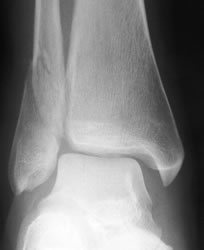
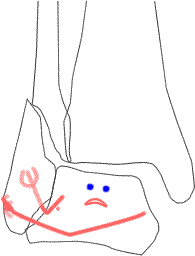
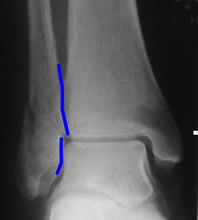
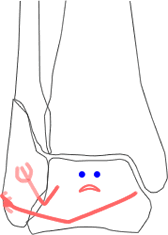
In transverse section:

Stability is a very important concept in ankle fractures. The normal stabilisation mechanisms of the ankle are preserved in many fractures, so they will not displace under normal loading. The "precautions" that are often taken in managing ankle fractures (such as plaster casts, avoidance of weightbearing and check radiography) are unnecessary in stable fractures, and those that have been stabilised by surgery.
The bony mortise is the most important factor in stabilising the ankle when it is loaded. Putting weight on the ankle makes the talus fit closely into the mortise, and the shape of the bones produces stability. As it does so, it may move 1-2mm laterally, finding the "best fit" position.
Without axial loading, the ligaments become more important for stability, especially in plantar flexion. The anterior talofibular ligament is most important in plantar flexion. The calcaneofibular, posterior talofibular and tibiofibular ligaments are more important in plantigrade/dorsiflexion - the data are less clear for this position. The superficial deltoid ligament resists valgus strain and also contributes to stabilising the midfoot in early stance phase. The deep deltoid acts as a check-rein on the talus, resisting external rotation and translation - this is a crucial function in most ankle fractures.
Experiments by Lauge-Hansen in the 1940s suggested that some types of ankle fractures might be more stable than others. However, opinion tended to favour reduction and stabilisation of even slightly displaced fractures. The AO group contributed to this culture. In addition, Yablon published a very influential paper in 1979, in which he showed that in displaced ankle fractures, "the talus follows the fibula" (though he did not study stable fractures or examine what determines stability). This led to concern that any fibular displacement would lead to equivalent displacement of the talus, with resulting ankle incongruity. There was an emphasis on the fibula as a stabilising buttress, and on stabilising the fibula in fixing ankle fractures.
 |
 |
 |
In transverse section: |
| Yablon's finding that in displaced fractures "the talus follows the fibula"... | ...was applied to fractures with only a small amount of fibular displacement and no talar displacement at all, implying that in a fracture such as this talar position is dependent on the fibula, and that the small amount of fibular displacement represents external rotation of the distal fibula, carrying the talus into an incongruent position |  |
|
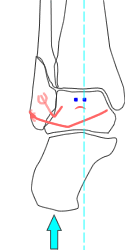 |
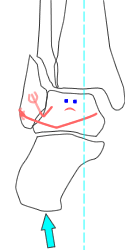 |
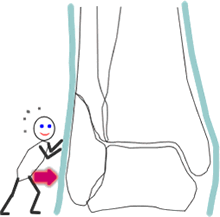 |
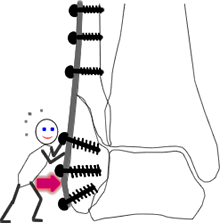 |
There is also a belief that weightbearing on a fractured ankle will lead to displacement; insofar as this is rationalised it appears to be because ground reaction force is applied lateral to the midpoint of the ankle |
Stabilisation of the ankle is therefore believed to be achieved by reducing the fibula, which then acts as a buttress. The fibula is retained in place by a moulded plaster or an internal fixation implant | ||
More recent biomechanical work by Michelson and others shows that the deep deltoid check-rein function is what determines the stability of an ankle fracture. Provided the deep deltoid ligament remains intact and attached to the tibia, the talus will not displace in the mortise, no matter what happens to the lateral side or the syndesmosis. However, if the DTTL is ruptured, or detached form the tibia by a medial malleolar fracture, the talus is potentially unstable and will tend to follow the fibular displacement. Axial loading (in simple terms, "walking on it"!) does not increase talar instability unless there is a significant defect in the tibial plafond, but how large this has to be is not known for certain – probably somewhere between 25-40%.
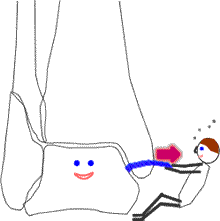 |
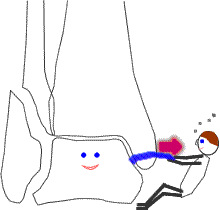 |
 |
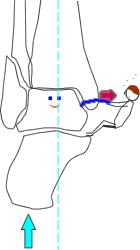 |
| If the deep deltoid ligament is intact, it will keep the talus congruent in the mortise... | ...even if the fibula is displaced | CT studies show that in fractures with an intact deep deltoid, the talus is congruent with both malleoli, and the distal fibula is not externally rotated. Instead, the proximal fibula is internally rotated (probably due to the unopposed extensors pulling on their origin) | With an intact deep deltoid, weightbearing on the ankle simply settles the talus into the mortise. Walking on a fracture with an intact deep deltoid will not cause displacement |
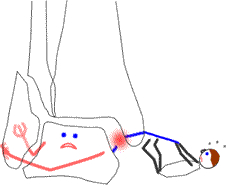 |
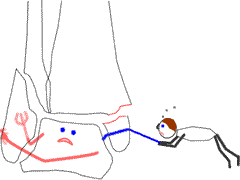 |
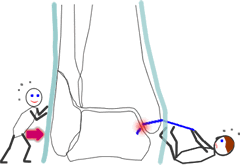 |
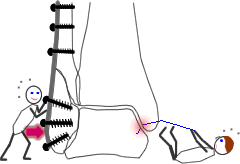 |
| If the deep deltoid tears, or the medial malleolus fractures, detaching the deep deltoid from the tibia, "the talus follows the fibula" | Reduction of the fibula and stabilisation with a cast or internal fixation implant will now provide some stability to the injured ankle (though if the ligament is torn it will not be fully stabilised) | ||
So there is basic science and clinical evidence that some fractures might have an intact deep deltoid ligament and behave in a stable manner. They would have an undisplaced mortise, even if there was slight displacement of the fibula. How common are such fractures, and are they clinically as benign as the above evidence suggests?
Back to first page in biomechanics section
Back to previous page (movement)
Forward to next page (contact and pressure)